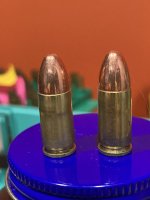wvsurgshooter
Member
I have reloaded a bunch of 9 mm brass using 231 Winchester powder 4.1 grain, small pistol Remington primers, with 9 mm 124 grain Berry's round nose, OAL 1.162 on average and yet after crimping, many will not fit in the 9 mm Wilson gage. Some do and yet some do not and I do not understand why when I am using the same technique. Is it due to the fact that the brass I pick up is varied and some are Federal, some RC, etc?
The one on the left seems to have a very subtle bulge and the one on the right fits perfectly in the Wilson gage.
Would appreciate any suggestions
Thank you
The one on the left seems to have a very subtle bulge and the one on the right fits perfectly in the Wilson gage.
Would appreciate any suggestions
Thank you


